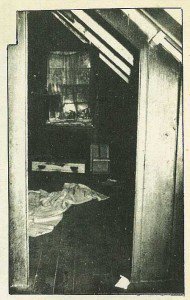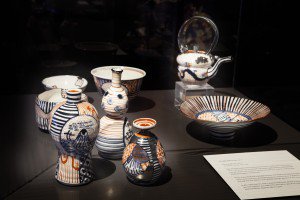Cottage Congoleum considered
The removal of collection items from Wyllie Cottage has been completed, and work on the restoration of the building is now well underway. A total of 316 museum collection items including 35 large domestic items, framed works, and smaller items consisting of soft furnishings (textiles), clothing, ceramics, glassware, books, small framed works, children’s toys and sundry domestic equipment were moved from the cottage to the museum’s storage facility within 12 weeks. In between the transfer from Wyllie Cottage to storage, every object was photographed, condition reported, cleaned, underwent preventative conservation treatment, re-photographed, catalogued, and re-housed.
This post delves into the history behind one of my favourite items from the cottage, the 2300mm x 2740mm Congoleum rug, a favourite for aesthetic reasons, and because it was a challenging item to work with.

1979.64 [9116] Congoleum rug in situ, Wyllie Cottage bedroom, November 2015
The design for the rug was based on a 1922 pattern called ‘Staggwood’. The central part of the rug has a beige background, with a floral pattern predominantly in brown, yellow, red, green and blue. The border has a blue background with geometric and floral designs predominantly in brown, yellow, red, green and blue.
The rug was exhibited on the upstairs bedroom floor in Wyllie Cottage and was one of the last objects to be removed. In order to transport and store the rug, it needed to be rolled. The amount of space required to store such large items flat is impractical. Most large textile items stored in museums, such as carpets, curtains, flags, and patchwork quilts to name a few, are stored on specially constructed rolls. In order to roll the rug, it needed to be slightly and carefully heated, in order to give it malleability. In order to heat the rug, my colleague Allison Campbell and I armed ourselves with masks, gloves, a hairdryer and a heat gun, on one of the hottest days of summer. With careful planning and preparation the rug was successfully heated, rolled, cleaned, removed, and rehoused. Thanks to our Kaitiaki Māori Tapunga Nepe, Exhibitions and Maintenance Technician Jonty Hall, and Education Officer Aaron Compton for their assistance in carefully manoeuvring the rolled rug down the steep and narrow stairwell.
The development of Congoleum
Congoleum traces its origins back to the early 1800s and Kirkcaldy, Scotland, where Michael Nairn expanded his family’s successful sailcloth business into the manufacturing of painted floor cloths. Nairn’s painted floor cloths quickly became a popular item, as they were a practical and inexpensive way of covering the swept dirt floors that were the standard in working class homes of the period.
In the mid-1800s Frederick Walton, a young Englishman, invented linoleum, a smooth flooring made from a solidified mixture of linseed oil, flax, cork, wood flour and pigments. Michael Nairn began manufacturing this new product and established a branch in the US.
In 1902 while Nairn was establishing himself in New Jersey a small roofing company in Pennsylvania, the United Roofing and Manufacturing Co began producing “Congo” roofing, supposedly named for the fact that asphalt used as a saturate in the roofing material came from the African Congo.
It soon became evident that the three foot wide strips of Congo roofing material could easily be used as floor runners to deaden noise and minimize dust and dirt. To differentiate between the Congo roofing and the flooring material, the flooring was given the name Congoleum: a contraction of Congo and Linoleum.(1)

1979.64 [9116] Congoleum Rug: detail of label on reverse. On the reverse side of the bottom right hand corner are two paper labels printed in blue ink: “SILVER STAR / CONGOLEUM RUG” and “PATTERN NO [illegible] 01 / SIZE 7FT 6 INS x 9FT”.
The backs of the rugs were covered with red iron oxide and since these products were marketed as ‘rugs’, they were often printed to resemble various kinds of woven or knotted carpets, including oriental rugs, or “Art Rugs”. (3)
It wasn’t long before Congoleum rugs were readily available to consumers in New Zealand as the advertisment below from The Poverty Bay Herald, dated 1919, shows. Underneath the advertisement is a list of Congoleum Service Stores in the Gisborne region:
Parnell Limited; F. S. Malcolm and Co.; Grundy and Shennan, Ltd. John Townley; Whinray, Martin, Ltd.; Common, Shelton and Co., Limited. TOKOMARU BAY— Qates Bros. AND OTHER LEADING DEALERS. CONGOLEUM PRICES: To cover freight and handling charges, it may be necessary for Provincial Dealers to add to above prices not more than 3d per running yard for Congoleum by the yard, and 1/6 for each Congoleum Art Rug.

Poverty Bay Herald 1919. Column 1, Volume XLVI, Issue 15082, 3 December 1919, Page 11.
Jane Powell, author of several books, including Bungalow Kitchens and Linoleum wrote of Congoleum rugs “for sheer practicality, not to mention amusement value, can there be any finer form of fakery than the linoleum rug? Imagine, all the visual loveliness of a woven carpet without the vacuuming, shampooing, and worrying about spills—just damp-mop and you’re done!”
It is unlikely this product will ever be made again. The few companies producing real linoleum don’t offer patterns, let alone rugs, and no one makes felt-base flooring anymore. We are fortunate to have a good surviving example of a locally used Congoleum rug in the museum’s collection, an unusual, yet popular interior decorating product for the ‘modern’ mid-twentieth century consumer.
Megan Hansen-Knarhoi, Collections Technician
(1) http://www.congoleum.com/History-and-Heritage/
(2) http://www.oldhouseonline.com/history-of-linoleum-rugs/
(3) http://www.oldhouseonline.com/history-of-linoleum-rugs/



